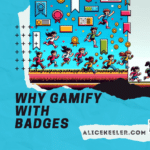Please feel free to use this resource with students or in teacher trainings.
Please do not republish to your blog.
Link to Google Drawing: https://goo.gl/LlCgQ5
New Literacy
The new literacy is to teach students how to search. Rather than giving students answers, we ask really good questions. Students then use advanced search techniques to find the answers. Most important is then… what do they do with that information? Higher DOK levels would have the student formulating their own statements and supporting those statements with research rather than simply gathering facts.
Scaffold Research
Students are likely going to struggle with answering essential questions. A good question can not be answered on a single website or with a single Google search.
Advanced Search
Start students off by learning advanced search techniques. A Google A Day (http://www.agoogleaday.com/) is a great gamified warm up activity for students. If you think you know how to conduct a search, you probably do not. Pass the Power Searching with Google MOOC (http://www.powersearchingwithgoogle.com/) and you will realize you were a novice searcher. Encourage students to take the course. Even if students do not take the Power Searching course, include the techniques you learn in the course into your instruction.
Multiple Days
These suggestions are not intended to be done in a single day unless this is the content you are teaching. Instead, this can be used as a warm up or break. Each step may be practiced over multiple days before moving onto the next technique.
Ask A Question
Ask a good essential question that you have no intention of answering with the students. This allows you to ask something hard but really interesting. “How would you jump the Grand Canyon with a tricycle?” Spark the students curiosity.
1) Brainstorm Keywords
Ask the students what keywords they would use in a Google search to answer this question. Do not search the keywords, simply work with students on choosing better keywords.
A keyword is a word that is actually present on the web page. If you want to find out about the topic “Dog Research” it is unlikely that the word “research” is actually on the results page of what you are looking for.
Consider plural and non-plural words. Volcano OR Volcanoes.
Consider the order of the words. Placing the keywords in a different order can yield different results.
Identify other words that may be used. Think of synonyms, jargon and other terms.
Do NOT Search Questions
Remember, you are looking for words that appear on the web page. Usually, a question is not part of the web page content.
Instead of “What kinds of dogs are used in dog sledding” simply search “dogs OR dog sledding.”
Search
After spending some time working with students on brainstorming keyword searches, have them search. The students are not trying to answer the question, but instead to analyze the quality of the search results based on different keyword search techniques. Did they get different results when they searched Volcanoes instead of volcano. Give the students different keyword challenges to try and have them record the differences between the search results.
2) Advanced Search
Once students have practiced doing keyword searches, up the game by asking students to use advanced search techniques.
Quotations: Place quotations around keywords to find the exact match of the words together in the results.
Not: Place a minus sign in front of keywords that you want to exclude from the search.
Site:.edu: Include Site:.edu in the search box to return results from educational institutions.
OR: Use the Boolean search technique of OR or use AND when doing keyword searches.
Students will again compare their results, but not attempt to answer the question.
3) URL’s
Students need to verify the credibility of the sites they are using for their evidence. Ask students to conduct keyword searches to answer a question, but ask them not to click on any of the links. Instead ask students to break down the URL’s and determine the credibility of the sites.
Suggestion to have students fill out a spreadsheet where they list the URL’s of the websites in their search results in one column. In another column, the student should explain why they think the URL is credible or not.
Have students critique each other’s reasoning.
4) Control Click
After conducting a keyword search, students will want to hold down the control key on the links they thought were credible. Holding down the Control key opens the search result in a new tab. Students can click on all the links they determined were worth looking at and then tab through each of the search results.
Credibility
It is important for students to assess the credibility of their sources. Emphasize that not everything on the internet is true (see the Tree Octopus). There is no foolproof way to ensure that sites are credible, but there are some clues students can look for.
Note: sites that end in .org are no more credible than sites that end with .com. Sites that end with .edu are more likely to be credible. However, there is not necessarily a fact checker of those with access to create web pages at educational institutions.
Check out Catlin Tucker’s “Got Credibility” Form: http://goo.gl/mjymB8
Look For
- Who is the author?
- Who sponsored the site?
- Does the site have spelling and grammar errors?
- Does the site URL end in EDU?
- Is this a Blog? Is this a Wiki?
- What reason would the author have to have a bias?
- What are other points of view?
- Does the site have excessive advertisements?
- While web design does not determine credibility, a poor quality design can indicate a potentially less credible site.
- Look at the URL. Are there parts to the URL that point to a less than credible source?
5) Control F
The ability to skim a page is a learned skill. Students can not read all of the results from the Google search. Control F does a find on the page. Students will want to use Control F and type in a keyword. Pressing enter jumps the student to the next instance of the keyword on the site. Students will want to look at the context of the keyword to see if it indeed fits in with what they are looking for.
6) Control W
Conducting a web search for bananas yielded me 63 million results. Clearly students can not read all of the results of their search. Using advanced search techniques and keyboard shortcuts helps students to more quickly conduct research. After holding down the Control key to click on the link in the search results, conducting a Control F find of keywords, students will want to use Control W to close the tab. This brings them back to the search results page to allow them to continue their search quickly.












4 thoughts on “6 Steps to Teaching Students to Search”
Alice
Great material!
I have used a number of these Techniques in both my “Five Ways to Improve Your Searching in Five Minutes” and “Recursive Web Searching Technique”.
You may be interested in a number of my searching resources at – http://techweb.apps.sparcc.org/searching
I think there ARE some times where searching a question is appropriate. If you really want to answer a specific question, that can be the fastest way. If you search “What kinds of dogs are used in dog sledding” you get an answer to that specific question right at the top of the results.
That absolutely can work. Using advanced search techniques might return better (different) results.
Thanks for this! I love it. One observation though…I think there ARE times when it is good to ask a question. If you are really looking for an answer to a specific question, it can be much quicker if your search is very specific. If you search “What kinds of dogs are used in dog sledding” you will get an answer right at the top of the search results, which can be a real time saver.